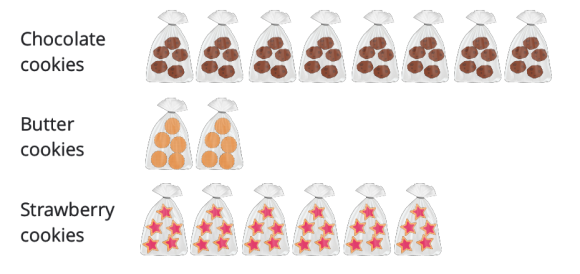Ratio
In this article, we are going to learn about the ratios and the fractions as per the Primary 6 Maths level.
The learning objectives are
- Relationship between ratio and fraction
- Simple word problems involving ratios
This article can serve as a refresher for the ratios and fractions concepts as taught in P5.
What is a Ratio?
A ratio tells us the relationship between two or more quantities. It may not represent the actual number.
For quantities with units (e.g. kg, m), we must remember to express them in the same units before expressing them as ratios. There are no units in the ratio.
Example 1:
Two brothers have some money. Tom has \($10\) and Donnie has \($15\). Express the amount of money Tom has to the amount of money Donnie has as a ratio in its simplest form.
Solution:
\(\begin{align} \text{Tom} &: \text{Donnie}\\[2ex] 10 &: 15\\[2ex] 2 &: 3\\[2ex] \end{align}\)
Answer:
\(2 : 3\)
Equivalent Ratio
Similar to fractions, there are equivalent ratios. We express ratios in their simplest form by dividing each term by a common factor.

\(24 : 16\), \(12 : 8\), and \(3 : 2\) are equivalent ratios. The ratio \(3 : 2\) is in its simplest form.
Fraction And Ratio
Other than using a ratio to compare two quantities, we can also express one quantity as a fraction of another.
A ratio can be expressed as a fraction and a fraction can be expressed *as a ratio.
Example 2:
Tom has \($5\) and Donnie has \($2\).
A. Express the amount of money Tom has to the amount of money Donnie has as a ratio.
Solution:
\(\begin{align} \text{Tom} &: \text{Donnie}\\[2ex] 5 &: 2 \end{align}\)
B. Express the amount of money Tom has as a fraction of the amount of money Donnie.
Solution:
\(\begin{align} \frac{\text{Tom}}{\text{Donnie}} = \frac{5}{2} \end{align}\)
Practice Questions
Now let us try some simple questions to understand the concept.
Question 1:
See the picture given below.

A. The ratio of the number of cups to the number of saucers is __________ : __________.
Solution:
Number of cups \(= 3\)
Number of saucers \(= 7\)
\(\begin{align} \text{Cups} &: \text{Saucers}\\[2ex] 3 &: 7 \end{align} \)
Answer:
\(3 : 7\)
B. The ratio of the number of saucers to the number of cups is __________: __________.
Solution:
Number of saucers \(= 7\)
Number of cups \(= 3\)
\(\begin{align} \text{Saucers} &: \text{Cups}\\[2ex] 7 &: 3 \end{align}\)
Answer:
\(7 : 3\)
C. The ratio of the number of cups to the total number of cups and saucers is __________ : __________.
Solution:
Number of cups \(= 3\)
Total number of cups and saucers\(\begin{align}&= 3 + 7\\[2ex] &= 10 \end{align}\)
\(\begin{align} \text{Cups} &: \text{Total number of cups and saucers}\\[2ex] 3 &: 10 \end{align}\)
Answer:
\(3 : 10\)
Question 2:
Solve the following,
\(24 : 18 = 4 :\)__________
Solution:

Answer:
3
Question 3:
Solve the following,
__________ \(: 15 = 35 : 21\)
Solution:
Step 1:
Find the simplest form of \(35 : 21\).

\(35 : 21 = 5 : 3\)
Step 2:
Find the equivalent ratio of \(5 : 3\).

We get
\(25 : 15 = 5 : 3\)
Answer:
\(25\)
Question 4:
Chris has \(\displaystyle{\frac{2}{5}}\) as many marbles as John.

- The ratio of the number of marbles Chris had to the number of marbles John had is __________ : __________.
- The ratio of the number of marbles John had to the number of marbles Chris had is __________ : __________.
- The ratio of the number of marbles Chris had to the total number of marbles the two boys had is __________ : __________.
- The number of marbles John had is __________ of the number of marbles Chris had.
- The number of marbles John had is __________ of the total number of marbles the two boys had.
Solution:
Number of marbles Chris had \(\displaystyle{=\frac{2}{5}}\) number of marbles John had
- The ratio of the number of marbles Chris had to the number of marbles John had is 2 : 5.
- The ratio of the number of marbles John had to the number of marbles Chris had is 5 : 2.
- The ratio of the number of marbles Chris had to the total number of marbles is 2 : 7.
- The number of marbles John had \(\displaystyle{\frac{5}{2}}\) of the number of marbles Chris had.
- The number of marbles John had is \(\displaystyle{\frac{5}{7}}\) of the total number of marbles the two boys had.
Question 5:
Cookies were sold in packs of 5 each. Mrs Tong bought 8 packs of chocolate cookies, 2 packs of butter cookies and 6 packs of strawberry cookies.

- Express the ratio of the number of chocolate cookies to the number of butter cookies to the number of strawberry cookies Mrs Tong bought in its simplest form.
- Express the number of chocolate cookies as a fraction of the total number of cookies Mrs Tong bought in its simplest form.
Solution:
A.
Number of cookies in each pack \(= 5\)
Number of packs of chocolate cookie \(= 8\)
Total number of chocolate cookies\(\begin{align} \displaystyle &= 8 \times 5\\[2ex] &=40 \text{ cookies} \end{align}\)
Number of packs of butter cookie \(= 2\)
Total number of butter cookies\(\begin{align}\displaystyle &= 2 \times 5\\[2ex] &=10 \text{ cookies} \end{align}\)
Number of packs of strawberry cookie \(= 6\)
Total number of strawberry cookies\( \begin{align}\displaystyle &= 6 \times 5\\[2ex] &=30 \end{align}\)

Answer:
\(4 : 1 : 3\)
B.
Number of packs of chocolate cookie \(= 8\) packs
Total number of packs of cookie\(\begin{align}\displaystyle &= 8 + 2 + 6\\[2ex] &=16 \text{ packs} \end{align}\)
\(\begin{align} \frac{\text{ Number Of Chocolate Cookies }}{\text{ Total Number Of Cookies }} &= \frac{40}{80} \\[2ex] &= \frac{8}{16} \\[2ex] &= \frac{1}{2} \end{align} \)
Answer:
\(\displaystyle{\frac{1}{2}}\)
Question 6:
A sum of money is shared among Matthew, Paul and Luke in the ratio \(9 : 3 : 4\)
- Express Matthew’s share as a fraction of Luke’s share.
- What fraction of Paul’s share is Mathew’s share?
- What fraction of the total share is Luke’s share in its simplest form?
Solution:
A.
Matthew : Paul : Luke \(=9 : 3 : 4\)
\(\displaystyle{\frac{\text{Matthew}}{\text{Luke}} = \frac{9}{4} = 2\frac{1}{4}}\)
Answer:
\(\displaystyle{2\frac{1}{4}}\)
B.
Paul’s share \(= 3\) units
Mathew’s share \(= 9\) units
\(\displaystyle{\frac{\text{Matthew}}{\text{Paul}} = \frac{9}{3} = 3}\)
Answer:
3
C.
Luke’s share \(= 4\) units
Total share
\(= 9\) units \(+ \;3\) units \(+ \;4\) units
\(= 16\) units
\(\displaystyle{\frac{\text{Luke}}{\text{Total}} = \frac{4}{16} = \frac{1}{4}}\)
Answer:
\(\displaystyle\frac{1}{4}\)
Question 7:
Ali’s savings is \(\displaystyle 1\frac{2}{5}\) times that of Rose’s.
- Find the ratio of Ali’s savings to their total savings.
- Find the ratio of Ali’s savings to the difference between Ali’s and Rose’s savings.
Solution:
A.
Ali’s savings \(\displaystyle =1\frac{2}{5}\) times Rose’s savings
Ali’s savings \(\displaystyle =\frac{7}{5}\) times Rose’s savings
Total savings \(= 7\) units \(+ \;5\) units
\(= 12\) units
The ratio of Ali’s savings to their total savings is \(7 : 12\).
Answer:
\(7 : 12\)
B.
Ali’s savings \(= 7\) units
Rose’s savings \(= 5\) units
Difference between Ali’s and Rose’s savings
\(= 7\) units \(- \;5\) units
\(= 2\) units
The ratio of Ali’s savings to the difference between Ali’s and Rose’s savings is \(7 : 2\).
Answer:
\(7 : 2\)
Question 8:
On the bookshelf, for every 3 fiction books, there are 5 non-fiction books. If there were a total of 432 books, how many fiction books are there?
Solution:
\(\begin{align} \text{Fiction} &: \text{Non-Fiction}\\[2ex] 3 &: 5 \end{align}\)
Total number of books (in units) \(= 3\) units \(+ \;5\) units
\(= 8\) units
Since there were a total of 432 books, 8 units is 432.
\(\begin{align} 8 \text{ units} &= 432\\[2ex] 1 \text{ unit} &= 432 \div 8\\[2ex] &= 54 \end{align}\)
Number of fiction books
\(= 3\) units
\(= 3 \times 54\)
\(= 162 \)
Answer:
\(162\) books
Question 9:
The length of a rectangle is 4 times its breadth. Its perimeter is 30 cm. Find its area.
Solution:

\(\begin{align} \text{Length (L)} &: \text{Breadth (B)}\\[2ex] 4 &: 1 \end{align}\)
Perimeter of rectangle\(\begin{align}&= 2 \times \text{ (L + B)}\\[2ex] &= 2 \times (4 \text{ units} + 1 \text{ unit})\\[2ex] &= 10 \text{ units} \end{align}\)
\(\begin{align} 10 \text{ units} &= 30 \text{ cm}\\[2ex] 1 \text{ unit} &= 30 \text{ cm} \div 10\\[2ex] &= 3 \text{ cm} \end{align}\)
Length (L)\(\begin{align}&= 4 \text{ units}\\[2ex] &= 4 \times 3 \text{ cm}\\[2ex] &= 12 \text{ cm} \end{align}\)
Breadth (B)\(\begin{align}&= 1 {\text{ unit}}\\[2ex] &= 3 \text{ cm} \end{align}\)
Area of rectangle\(\begin{align}&= \text{L} \times \text{B}\\[2ex] &= 12\text{ cm} \times 3\text{ cm}\\[2ex] &= 36 \text{ cm}^2 \end{align}\)
Answer:
\(36 \text{ cm}^2\)
Question 10:
At a party, the number of children was \(\displaystyle\frac{7}{3}\) the number of adults. If there were 225 adults, how many children were at the party?
Solution:
\(\begin{align} \text{Children} &: \text{Adults}\\[2ex] 7 &: 3 \end{align}\)
Number of children \(= 7\) units
Number of adults \(= 3\) units
Since there were 225 adults,
\(\begin{align} 3 \text{ units} &= 225\\[2ex] 1 \text{ unit} &= 225 \div 3\\[2ex] &= 75 \end{align}\)
Number of children\(\begin{align}&= 7 \text{ units}\\[2ex] &= 7 \times 75\\[2ex] &= 525 \end{align}\)
Answer:
\(525\) children
Question 11:
\(\displaystyle\frac{1}{4}\) of May’s savings was equal to \(\displaystyle\frac{3}{7}\) of Rena’s savings. Find the ratio of May’s savings to Rena’s savings.
Solution:
\(\displaystyle{\frac{1}{4}}\) of May’s savings \(\displaystyle{=\frac{3}{7}}\) of Rena’s savings
\(\displaystyle{\frac{3}{12}}\) of May’s savings \(\displaystyle{=\frac{3}{7}}\) of Rena’s savings
Once the numerator is made the same, we can refer to the denominator to get the total number of units representing May’s savings and Rena’s savings.
\(\begin{align} \text{May’s savings} &: \text{Rena’s savings}\\[2ex] 12 &: 7 \end{align}\)
Answer:
\(12 : 7\)
Question 12:
\(\displaystyle{\frac{6}{7}}\) of Peter’s savings is thrice of Jon’s savings. Find the ratio of Peter’s savings to Jon’s savings.
Solution:
\(\displaystyle{\frac{6}{7}}\) of Peter’s savings is thrice of Jon’s savings.
\(\displaystyle{\frac{2}{7}}\) of Peter’s savings is equal to Jon’s savings.
So, Peter’s savings is represented by 7 units and Jon’s savings is represented by 2 units.
\(\begin{align} \text{Peter’s savings} &: \text{Jon’s savings}\\[2ex] 7 &: 2 \end{align}\)
Answer:
7 : 2
Conclusion
In this article, we learnt about the relationship between the ratios and fractions. We learnt that ratios can be expressed as fractions and fractions can be expressed as ratios.
We also solved simple word problems involving ratio.
Hope you have understood the concepts well. Keep practising.
 SG
SG  VN
VN 












